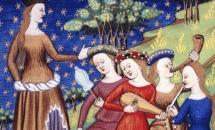Music was an important part of the education of princesses and the noblewomen who moved in court circles during the 16th century. The women of the upper classes had to possess musical knowledge and skills, even though their talents were usually only displayed in semi-private palace spaces. The young princesses used to learn to sing and play keyboard or stringed instruments, while wind instruments were not considered suitable for them. These women could truly express their interest in music by collecting – both music books and musical instruments – and by having musicians at their service.
Music also served to reflect the status of the woman: the political and symbolic power of queens, the wives of viceroys and female governors was clearly expressed through their private polyphonic chapels and the fanfares of emblematic instruments that announced their arrival or accompanied them as they took their leave.
Cycle: Women and Music
Organized by: Residence for Researches
